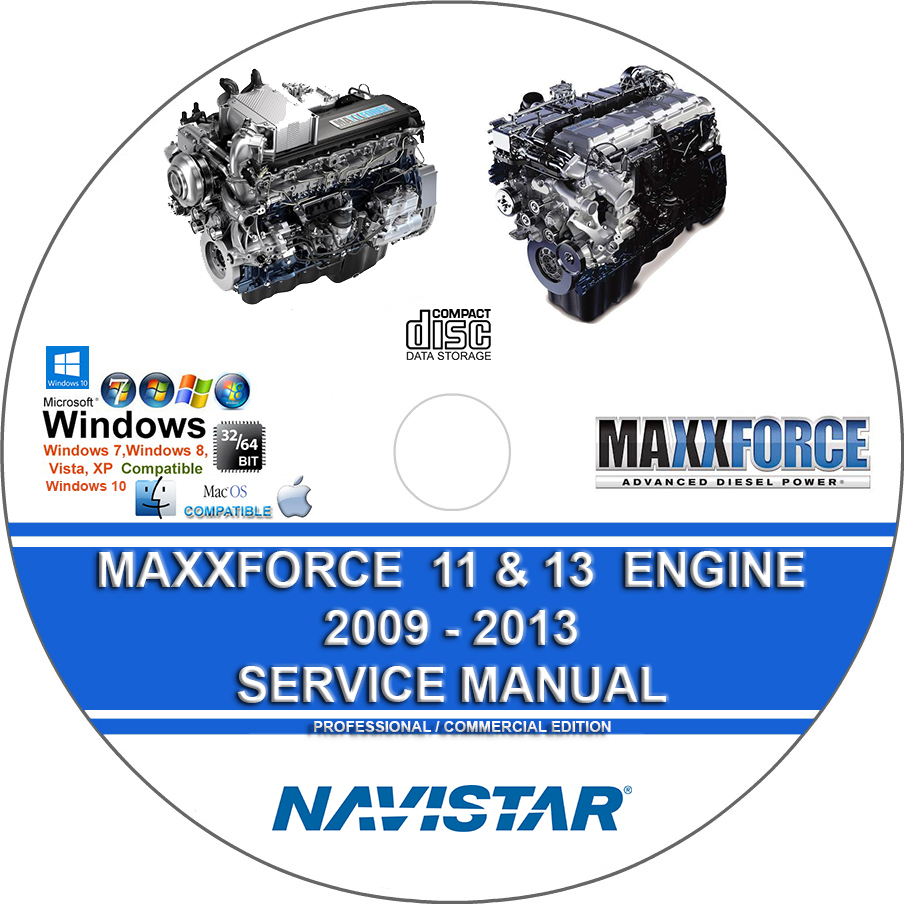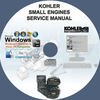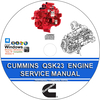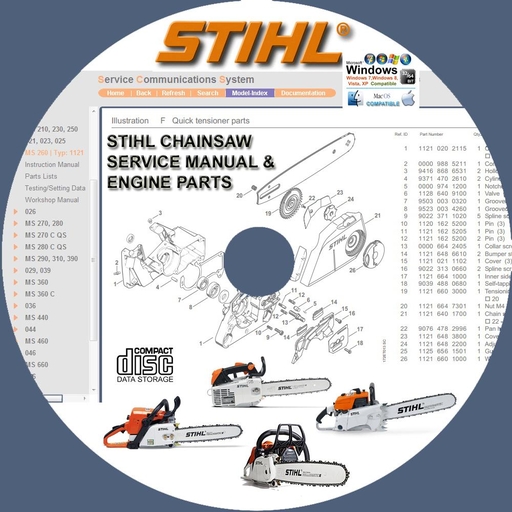Navistar MaxxForce 11 and 13 EPA10 Engine 2009 2010 2011 2012 2013 Factory Service Repair Manual Maxx Force
$39.00 – $48.00Price range: $39.00 through $48.00
Navistar MaxxForce 11 and 13 EPA10 Engine 2009 2010 2011 2012 2013 Factory Service Repair Manual Maxx Force
You can download this or I can ship it to you.
Loaded with Hi Resolution illustrations, instructions, photos, and diagrams, complete to service and repair your Engine.
1620 Pages
SKU: N/A
Categories: Heavy Machinery, MaxxForce
Navistar MaxxForce 11 and 13 EPA10 Engine 2009 2010 2011 2012 2013 Factory Service Repair Manual Maxx Force
Loaded with illustrations, instructions, photos, and diagrams, complete to service and repair your engine.
1620 Pages
MODEL YEAR:
2009 2010 2011 2012 2013
MODEL COVERS:
MaxxForce 11
MaxxForce 13
MANUAL COVERS:
MaxxForce 11, 13 EGES-415-2 (2009-2011):
Foreword
Service Diagnosis
Safety Information
Engine Systems
Mounting Engine on Stand
Engine Electrical
Cold Start Assist
After treatment System
Engine Retarder Control
Turbochargers
Air Compressor and Power Steering
Fuel System
Oil Cooler, Filter Housing and Crankcase Ventilation
Exhaust Gas Recirculation (EGR) System
Air Inlet Duct and Exhaust Manifold
Front Cover, High Mount Fan Drive, Cooling System, Related Components
Cylinder Head, Camshaft and Valve Train
Flywheel and Flywheel Housing
Oil Pan and Oil Suction Tube
Oil Pump, Low Mount Fan Drive, and Timing Gears
Power Cylinders
Crankcase and Crankshaft
Abbreviations and Acronyms
Terminology
Appendix A – Specifications Appendix B – Torques
Appendix C – Special Service Tools
MaxxForce 11, 13 (2012-2013):
Foreword
Service Diagnosis
Safety Information
Engine Systems
Mounting Engine on Stand
Engine Electrical
Cold Start Assist
After treatment System
Exhaust Back Pressure Control
Turbochargers
Air Compressor and Power Steering
Fuel System
Oil Cooler, Filter Housing and Crankcase Ventilation
Exhaust Gas Recirculation (EGR) System
Air Intake Throttle Duct and Exhaust Manifold
Front Cover, Fan Drive, Cooling System and Related Components
MaxxForce® Engine Brake by Jacobs
Cylinder Head, Camshaft and Valve Train
Flywheel and Flywheel Housing
Oil Pan and Oil Pickup Tube
Oil Pump and Timing Gears5
Power Cylinders
Crankcase and Crankshaft
Abbreviations and Acronyms
Terminology
Appendix A – Specifications
Appendix B – Torques
Appendix C – Special Service Tools
MaxxForce 11, 13 EPA10:
Foreword
Service Diagnosis
Safety Information
Engine Systems
Mounting Engine on Stand
Engine Electrical
Inlet Air Heater System
After treatment System
Exhaust Back Pressure Control
Turbochargers
Air Compressor and Power Steering
Fuel System7
Oil Cooler, Filter Housing, and Crankcase Ventilation
Exhaust Gas Recirculation (EGR) System
Air Intake Throttle Duct and Exhaust Manifold
Front Cover, Fan Drive, Cooling System, and Related Components
MaxxForce® Engine Brake by Jacobs
Cylinder Head, Camshaft and Valve Train
Flywheel and Flywheel Housing
Oil Pan and Oil Pickup Tube7
Oil Pump and Timing Gears
Power Cylinders
Crankcase and Crankshaft
Abbreviations and Acronyms
Terminology
Appendix A – Specifications
Appendix B – Torques
Appendix C – Special Service Tools
Appendix D – Technical Service Information (TSI
This manual is the same as the manual used by workshops. Service Manual contains detailed instructions and step by step diagrams for all workshop procedures.
Language: English
Format: PDF – Indexed and Searchable
COMPATIBLE WITH ALL WINDOWS & MAC COMPUTERS
(WINDOWS 11, WINDOWS 10, WINDOWS 8 ETC.)
Windows/Mac/Tablet/Phone Friendly
The Navistar MaxxForce 11 and 13 EPA10 engines (model years 2009-2013) were characterized by their use of an Advanced Exhaust Gas Recirculation (EGR) emissions strategy to meet 2010 EPA standards without selective catalytic reduction (SCR). However, this approach led to significant reliability issues and multiple lawsuits.
Key Features and Specifications
The MaxxForce 11 and 13 engines were big-bore diesel engines for the Class 8 truck market, known for some advanced design features:
- Design: In-line six-cylinder diesel engines with a compacted graphite iron cylinder block, which is stronger and more durable than traditional gray iron.
- Performance: Horsepower ratings ranged from 330 to 475 HP, with torque ratings from 1,250 to 1,700 lb-ft.
- Fuel System: Featured a high-pressure common rail fuel system with injection pressures up to 32,000 psi.
- Brake: An optional MaxxForce Engine Brake by Jacobs was fully integrated with vehicle controls for enhanced downhill braking.
- Durability Rating: Advertised with an impressive B-50 rating of 1.2 million miles, though real-world experience was often different due to emissions system issues.
Common Problems and Recalls
Navistar’s decision to use an EGR-only strategy resulted in systemic problems not seen in competitors who used SCR technology. The high temperatures and soot loads pushed the EGR technology beyond its limits.
- EGR System Failures: The primary problem was with the exhaust gas recirculation system, specifically the EGR coolers developing stress fractures due to severe thermal cycling. Coolant could leak into the exhaust, or exhaust gas could pressurize the cooling system.
- Turbocharger Issues: Soot contamination from high EGR rates caused turbocharger actuators to stick and fail, leading to a loss of boost pressure and further engine damage.
- DPF and Aftertreatment Problems: The diesel particulate filters (DPF) experienced massive soot loads, requiring frequent active regenerations, which consumed excess fuel and led to power loss.
- Oil Dilution: Fuel washing past the piston rings during frequent regenerations diluted the oil, reducing viscosity and leading to premature turbocharger bearing failures.
- Class Action Lawsuits: The engines were the subject of a major class action lawsuit, with fleets alleging Navistar knowingly sold engines with defectively designed emissions systems and concealed the problems. Navistar ultimately settled the class action for $135 million.
- Safety Recalls: Recalls were issued for various issues, including one in 2012 for a potential electrical short caused by an alternator cable rubbing on a power steering hose.
| Medium | USB Flash Drive, DVD, Download |
|---|
Related products
$34.00 – $42.00Price range: $34.00 through $42.00
$34.00 – $42.00Price range: $34.00 through $42.00
Heavy Machinery
$34.00 – $42.00Price range: $34.00 through $42.00
$34.00 – $42.00Price range: $34.00 through $42.00
$34.00 – $42.00Price range: $34.00 through $42.00
Heavy Machinery
$39.00 – $48.00Price range: $39.00 through $48.00
$34.00 – $42.00Price range: $34.00 through $42.00
$34.00 – $42.00Price range: $34.00 through $42.00











